- Insights into Maratha history, period Shivaji
to the Third Battle of Panipat (1627-1761) from Col Anil Athale book + reasons
for loss in Panipat and its impact.
Usually, I avoid reading books on history because they are thick and my reading pace slow. Since I have been reading Col Athale’s articles on Rediff.com for years knew about his writings, sharp mind and understanding of military strategy. So I was happy to know about his book.
The good part is it is all of 241 pages within which Col Athale (retd) covers Maratha history from Shivaji (born 1627) to its end i.e. around 1820s. What I also liked is that it provides insights and analysis of events then. It gives shortcomings in Maratha strategy in a non-biased way, at the same time heaps praise when earned & how Saints and society contributed to Shivaji’s success.
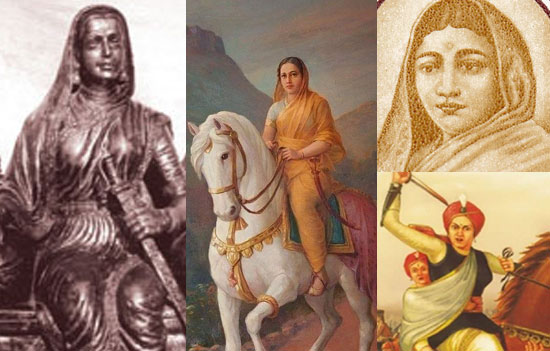 I wish book had covered role of Maratha Queens Yesubai, Tarabai, Ahilyabai and Rani Laxmibai in some detail.
I wish book had covered role of Maratha Queens Yesubai, Tarabai, Ahilyabai and Rani Laxmibai in some detail.
It is happy to see many books on Maratha
History being published. For certain reasons, their history is not known across
India. To an extent, we must thank Bollywood for movies Mastani (Bajirao
Peshwa), Tanaji (Tanhaji Malasure), Manikarnika (Rani Laxmibai) and TV serial
on Ahilyabai Holkar for renewed interest in Maratha history.
Books such as by Col Athale put the
contribution of Marathas in perspective. This is important because Marathas of today do not brag about the contribution of their forefathers.
What I have tried to do is to give key information.
The focus is more on insights than detailed history. All from the book so full
credits to Col Athale and publisher Indus Source.
When matter taken verbatim from book it
is in inverted commas or else rephrased in normal font. My comments are in
italics. Summary is chapter-wise as appears in the book. I have added pictures
and given links to articles on site.
Hope you enjoy reading the book as much
as I did. To buy book online
The summary is divided into 2 parts. One
is from Shivaji to Battle of Panipat. Two, is Marathas and British. This part
covers Preface, Prologue, Laying the Foundation, Maratha Uprising, Conflict at
Sea, Maratha Disaster at Panipat.
Preface
1. “Why did the Marathas, who fought the Mughals so valiantly, succumb to the British so tamely?”
2. “Controversies and distortions during period of Shivaji’s rule are on account of the fact that the entire records of his rule were burnt on 19/10/1689, when the Mughals under Zulfikar Khan captured the Maratha capital of Raigarh.”
3. “With these multiple sources and working for over nine years, I feel satisfied that I have been able to get a fairly authentic picture of the epic Anglo-Maratha struggle for an empire in India.”
Prologue
1. The British acquired India from the
Marathas not the Mughals.
2. For close to thirty years (1771-1802)
it was the Marathas who ruled most parts of Central and North India. Read
Did
Muslims rule India for 800 years
3. Even in Maharashtra the victory of Maratha General Mahadji Shinde over the
British in the Battle of Wadgaon (near Pune) is forgotten not to forget
the Anglo-Maratha battle in Aligarh (in modern day Uttar Pradesh) in the early
19th century.
4.
Most are unaware that the Bhonsles of Nagpur ruled Orissa for a while
and their invasion of Bengal.
5. The fight between the Maratha Empire and English was not one-sided. Gen Wellesley, famous for history over Napolean) regarded the Battle of Assaye as the most difficult of his career. Read about Battle of Assaye
6. In the 13th century tribes
from Afghanistan captured most of the northern plains. Next, was a Seljuk Turk
Babur. Only Northern part of India fully came under Muslim domination.
7. “Restrictive practices for women, marriage ceremonies at midnight and the spread of fatalism were the side effects of this prolonged Muslim rule. The ancient history of India was supplanted by the court historians of Delhi.” That is the reason why even today weddings take place at night.
8. The mountainous area had very little agricultural surplus and its people lived a difficult life. This is Maharashtra. Shivaji warned Aurangzeb, “My land is harsh, the people born here are hardy. Your elephants and guns cannot move freely in this area. Should you try to subjugate my people, you will be met with fierce resistance?
9. “The rise of the Marathas lit the fires of early Indian nationalism. The slogan of Swaraj was first raised by Shivaji. He called it ‘Hindavi Swarajya’ or self-rule for the entire country.”
10. “Shivaji attempted to revive ancient Indian culture by commissioning a compendium of Sanskrit terms (Rajya Vyavahar Kosh).”
11. So why was Shivaji’s role diminished in our history? One, contemporary politics
in independent India sought to legitimise Mughal rule. Two, electoral politics
in Maharashtra diminished his stature by making him a parochial Maratha figure.
Three, the British need to exploit history to justify their role.
12. The British fought wars against the Sikhs and Gorkhas too but their history only admires them. One, they showed no interest in assuming a pan-India role. Two, they became staunch British allies in saving the empire when it was on the ‘verge of extinction in 1857-58’.
13. “It was misplaced Maratha generosity that permitted letting the British off the hook in the Battle of Wadgaon in 1779.” Decades later, post the 1965 and
1971 wars India let the Pakistan off the hook.
14. “The battles of Assaye and Laswari, proved that Shinde’s battalions, trained on European lines, were more than a match for the British army.” They were let down by the treachery of their commanders in the battles of Delhi, Assaye, Aligarh.
15. The Peshwa was not fully
independent. Major policy decisions were taken only a gathering of all the
Sardars (feudal lords) called the Maratha
Mandal.
16. Indians, including the then Marathas, had a weakness for a defensive instead of offensive strategy.
17. “The
uncovering of the past is an important component for the regeneration of
national pride, a pride i.e. based on genuine achievements of the past.”
Ch1 Laying the Foundation
18. “The Battle of Pratapgad was the first ever unambiguous military victory of Indic forces over imperial Islam in over 400 years of contest.”
19. “India escaped the fate of Persia due to the resistance offered by the Marathas from 1682 to 1707.” Read
Tarabai
lead the Marathas then
20. Maharashtra enjoyed peace till 1293
when Alauddin Khilji defeated the Yadavas of Devagiri (near Aurangabad).
21. Muslim rule was confined to cities. Remote and mountainous areas were unaffected by Khilji rule. Local jagirdars enjoyed lots of freedom.
22. “Shivaji’s men called MAVALE after the region they came from-Maval or hill regions of western Maharashtra-were hardy, wiry and devoted to their leader.”
23. Muslims invasions led to the rise of
the Bhakti Movement in Maharashtra where caste did not matter.
24. Sant Dyaneshwar (1275-1296), accepted
as the first amongst the warkari saints, spread the message of universal
humanism of Hinduism. This made the society cohesive that was otherwise divided
by caste.
25. Later, Sant Tukaram (contemporary of
Shivaji) wrote devotional poems and gave a practical shape to Indian
philosophy.
26. Samarth Ramdas openly advocated revolt and violence against Muslim tyranny.
27. The saint poets of Maharashtra
promoted Marathi language that united and preached universal brotherhood. So Hindu saints and poets awakened people
and motivated them to fight invaders. Like
Arya Samajis fought against Nizam of Hyderabad rule before 1947.
28. Maharashtra has no well-defined
class of Kshatriyas. It had part-time soldiers from amongst middle-caste land
tillers who took up arms after Dussehra. This plus awakening by saints-poets
gave the society a cohesion not found elsewhere.
29. So
warriors came from all sections of society. Shinde, Gaikwad, Angrey,
Holkar, all not warrior caste, made it to the top based on hard work/talent.
30. MAHARS,
regarded as untouchables, played role of village guards and so found easy
acceptance in Shivaji army. They manned the
intelligence gathering and communication and were called HARKARAY.
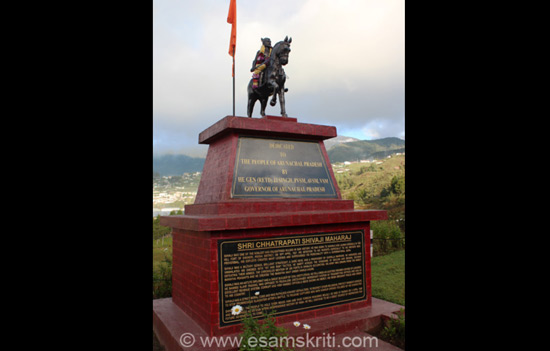 Shivaji pratima at Tawang, Arunachal Pradesh. 2013.
Shivaji pratima at Tawang, Arunachal Pradesh. 2013.
31. Shivaji was born in 1630 or some say 1627.
32. His father Shahji changed allegiance
many times between Sultan of Bijapur and Ahmednagar.
33. Shahji second wife Tukabai gave birth
to Ekoji, who later founded the kingdom of Tanjore in modern day Tamil Nadu.
34. Shivaji victory over Afzal Khan and
leading a commando raid on the Mughal camp in Pune brought him respect and
admiration.
35. “Shivaji laid the foundation of the Maratha Empire based on ‘Dev, Desh, Dharma (God, country, faith).”
36. He won by replying on ambush and raids, to compensate for smaller army.
37. Shivaji controlled nearly 432
mountain forts. It served as a base for his mobile forces. He had an extensive
spy network established by Bahirji Naik.
38. Shivaji divided forces into several
mobile columns, under an able General.
39. Shivaji exploited the vulnerable
lines of logistics communications of the Mughals by targeting their supplies
coming from the north.
40. “A sound
administration meant he had popular support, translated into timely intelligence
about enemy movement.”
41. He never faced both enemies i.e. Mughals and Sultan of Bijapur at the same time. He signed treaties as it suited his interests.
42. Pratapgarh 10/11/1659 – “The strategy that Shivaji followed, of exploiting a
victory and following it up with relentless offensive action, is a major change
from the Indian approach to war.”
43. By severing Afzal’s head, Shivaji forever destroyed the myth of Muslim superiority on the battlefield. Just like Saurav Ganguly’s team did by defeating Pakistan in Pakistan in 2004.
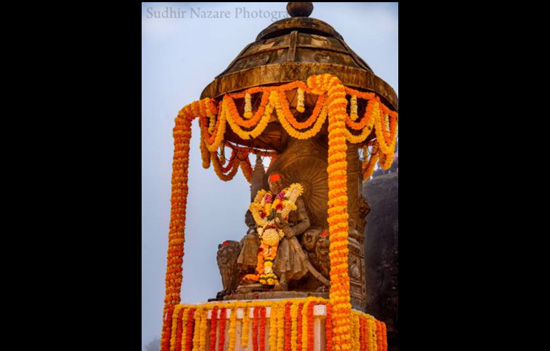 Shivaji pratima at Raigarh. Pranams.
Shivaji pratima at Raigarh. Pranams.
44. Shivaji
forced the enemy into battle at the place and time of his choosing. It was a template for future battles.
45. Aurangzeb Uncle Shaiste Khan
captured Pune. At midnight Shivaji led a raid with
200 soldiers against the Mughal army that numbered over 10,000. Khan
lost three fingers and survived, his sons and son-in-law did not.
46. Once the raid was over, Maratha troops in the hills of Katraj, tied torches to the horns of bullocks and on tree branches and set them alight (shown
in movie Bahubali). Mughals headed to Katraj, only to find bullocks.
Meanwhile Shivaji escaped to Sinhagad fort.
47. Rajput General Jai Singh put pressure on
Shivaji and asked him to collaborate with Aurangzeb. Post a series of events
Shivaji was placed under house arrest. From 12 May to 18 August 1666, he was
confined to Agra.
48. He escaped and reached Rajgad on
12/9/1666. It made him an all India figure. Read
The Saga of Shivaji – From Agra to Salher
49. Expecting a Mughal onslaught he made
Raigarh in Konkan his capital and shifted a part of his treasurer to fort of
Jinji, in modern day Tamil Nadu.
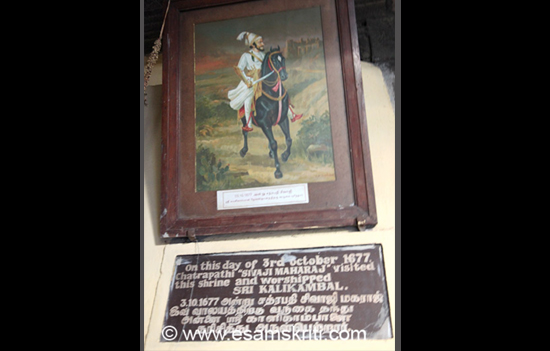 Shivaji visited this temple in modern day Chennai in 1677.
Shivaji visited this temple in modern day Chennai in 1677.
50. Ship building began in right earnest
at Vijaydurg and Sindhudurg.
51. By 1680, the Maratha Navy had 45 ‘pal’ or ships with twin decks, 150 ‘gurabs’ with twin sails and carring six guns and 1100 ‘galbats’ or small boats with single sail.
52. Shivaji coronation took place in 6/6/1674. Read Why
did Shivaji want to establish Swarajya
53. He instituted a full time paid army.
Maharashtra lacked financial resources like others so he was forced to carry
out raids in search of wealth. Maratha peasants
were reluctant to become full-time soldiers.
54. Shivaji failed to establish an
industry for manufacture of weapons.
55. Marathas attached prestige to
cavalry, were reluctant recruits for infantry. This reluctance became a
hindrance to adopting new methods.
56. Shivaji’s approach was annihilation of the enemy. Compromises were made due to the exigency of the situation. Chivalry had no places in his strategy.
57. He never went on the defensive even
in times of adversity.
58. “He was the first ruler in a thousand years to establish the primacy of political objectives in battles.”
59. “His
efforts as forging a pan-India Hindu unity failed due to Rajput obduracy but he
can be credited with being the first ruler to have an all-Indian vision of the
nation.”
60. Shivaji died in 1680. His successors
fought Aurangzeb for 25 years & won.
61. “It is no accident that Shivaji’s advance into Mughal-held territory was usually preceded Swami by Ramdas’s visit and his activity in establishing temples and followers.”
62. “Foreign historians were amazed that Indian peasants continued to till land while a battle raged less than a mile away.” Indian rules of fighting battles
were different. Read War
and Non-violence in the Bhagavad Gita
63. “Shivaji was one of the few Indian rulers of the 17th century who foresaw the threat the English posed to India.”
64. Marathas and English fought a naval war in the late 1670s. It resulted in a treaty between them. The Maratha base at Khanderi (off Bombay) was to be a constant source of trouble to the British’.”
65. The credit for keeping the English
at bay on the western coast goes to Admiral Kanhoji
Angrey. In 1698 the Marathas has 58 sea forts and a navy with ten big ships with 30-40 guns and 50 smaller ships with 4-10 guns each.”
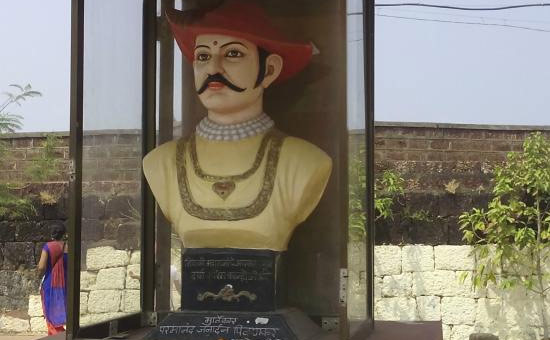 Kanhoji Angrey.
Kanhoji Angrey.
66. “But for Shivaji there would have been a continuous Islamic belt from Morocco to Indonesia.”
67. “He was
the first Indian ruler to discard war elephants. He believed in relentless
offensive strategy and never permitted the enemy time to re-group.”
Ch 2 Maratha Uprising
against Aurangzeb (1682-1707)
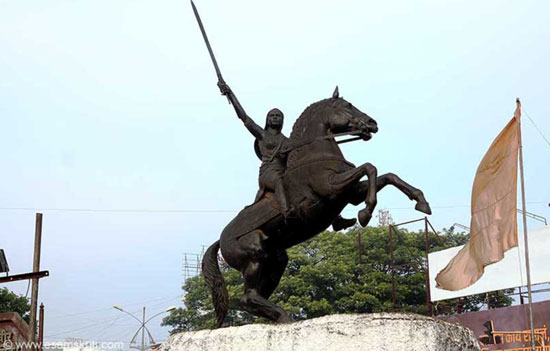 Maharani Tarabai, Kolhapur.
Maharani Tarabai, Kolhapur.
68. Shivaji son
Sambhaji was captured by Mughal forces in 1689. He was killed by March 1689, on the banks of the river Bhima, near Pune. Shivaji’s second son Rajaram escaped to the fort of Jinji, deep south.
69. Sambhaji wife Yesubai and son Shahu
fell into Mughal hands and were to spent the next 18 years as prisoners of the
Mughals. Read Return
of Yesubai
70. The fighting spirit of the Marathas over the next 18 years is a glorious chapter in Indian history. It was truly a ‘people’s war’ against the Mughals.
71. Rajaram died in 1700 but his queen Tarabai
continued the struggle.
72. Under pressure and circumstances,
Rajaram had to revive land grants, unlike Shivaji. This gave rise to Sardars or
feudal lots on whom the central authority had limited control.
73. Being short of resources, Marathas
looted Mughal territory. Often, these attacks brought untold miseries on local
population. It resulted in Marathas losing support outside Maharashtra unlike Shivaji’s time.
74. Maharashtra’s lack of mineral wealth and fascination for cavalry-de-emphasis on infantry mean ignoring development of fire-arms. This would come to haunt the Marathas vs. the English for whom infantry was becoming the dominant arm.
75. Shahu (Shivaji grandson) was crowned
as Chhatrapati at Satara on 12/2/1708.
76. Balaji Vishwanath secured the office of Peshwa or Prime Minister from Shahu for himself on 17/11/1713. Later on, it became hereditary.
77. Maratha Confederacy came into
existence in place of a tightly controlled single state as established by
Shivaji. Shinde (Scindia), Holkar, Gaikwad, Pawar reported to the Peshwa while
Sarkhel Angrey (Navy) and Sena Subha Bhonsle reported directly to Chhatrapati
Shahu.
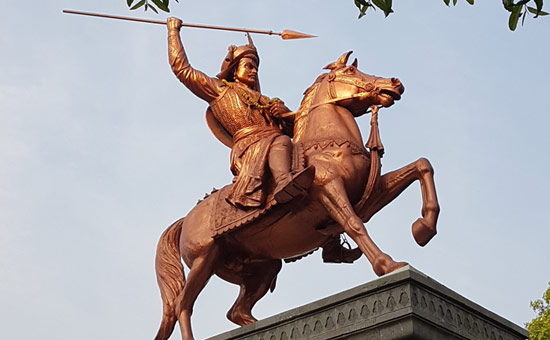 Bajirao Peshwa – The Empire Builder.
Bajirao Peshwa – The Empire Builder.
78. Bajirao became Peshwa in 1720. His
fighting machine was based on the concept of swift-moving cavalry. His mode of
warfare caught popular imagination in Maharastra, was followed by Yashwant
Holkar in 1804-5 and Tatya Tope in 1857-58. Read About Bajirao
Peshwa + Impact of
Bajirao on India of the 18th century
+ Why Bajirao is India’s greatest cavalry general + The Battle of Palkhed
79.
It was only once earlier during the time of Pulkeshi the Great in 606
had victorious armies travelled from South to North. It was mostly the
opposite.
80. Nadir Shah’s invasion in 1740 destroyed whatever was left to the Mughal empire. From then its jurisdiction was largely confined to Delhi.
Ch 3 Conflict at Sea (1679-1756)
81. It is only the western coast that
the British encountered opposition to their sea approaches (Marathas), none in
Calcutta and Madras.
82. Shivaji was the first modern ruler
to build a navy from scratch. Read Shivaji – A Naval visionary + A history of
Maratha Navy
83. Kanhoji Angrey, son of Tukoji
Angrey, was born in 1669. The Marathas had four shipbuilding yards.
84. The favourite method of attack of
the Marathas was to follow the British ships and attack them from behind.
85. Maratha tactics of not exposing their broadside but using a large number of smaller ships was used by the German ‘wolf packs’ of World War II.
86. From 1716 onwards, the British made several attempts to curb the Maratha navy by attacking the fort at Vijaydurg.
87. Peace reigned till 1756 when using
internal dissensions, the British combined with the Peshwa (Kanhoji died in
1729) to destroy the Maratha navy.
88.
Had it not been for the powerful Maratha
Navy under K Angrey, Bombay would have become the capital of the East India Co instead
of Calcutta.
89. “The main irritant in Portuguese Maratha relations was the activities of the missionaries-forcibly convert Hindus.”
90. On 15/5/1739 after a siege of nearly
two years, the stronghold of Bassein was in Maratha hands.
91. The British defeated the Maratha navy, how had a free run on the west coasts. The Marathas lost the means to keep in touch with the west. Sometimes we
fail to see the big picture when personal egos come in between.
Financially, the Peshwas were weak, the rich provinces were given to Generals
who rarely paid their share of revenue to the centre. Then or now one needs a strong Centre i.e. also financially strong.
Ch 4 Panipat 1761 and the
Power Vacuum in India
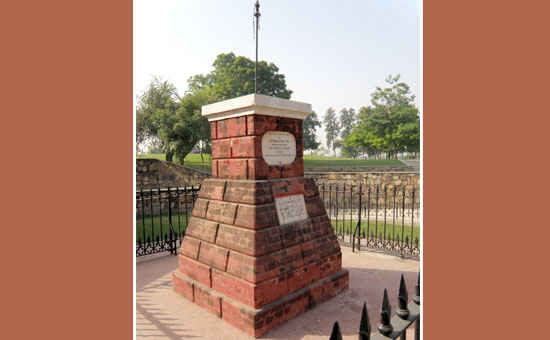 Pillar near where Battle of Panipat took place. Pic by Uday Kulkarni.
Pillar near where Battle of Panipat took place. Pic by Uday Kulkarni.
92. On death of Chhatrapati Shahu in
1749, a meeting called by Nanasaheb Peshwa attended by Maratha officials, it
was agreed that all executive powers for running the government would be
transferred to the Peshwas.
93. “Institutions like the village panchayat, the village headman and a revenue official looking after a group of villages are some e.gs that survive to date.”
94. “A corps of diplomats emerged for the first time as the Peshwa needed Ambassadors in several places”. 2 examples of modern government institutions.
95. The Huzurat or Peshwa’s army had 3 main components – Artillery-Muslims and North Indians; Infantry-Muslims and North Indians with firearms, and Cavalry-Mainly Maratha ‘Shiledar’ or part-time soldiers.
96. Peshwa introduced war elephants,
wrong move.
97. Due to changes, “the Peshwa army soon lost its Maratha character and became a mercenary force that was critically dependant on regular pay.”
98. Another key change. Till Bajirao
Peshwa time, appointment was based on merit-he encouraged young people of
humble background to reach the top. Now appointments became hereditary.
99. Partnership and alliances with Rajputs was part of Maratha policy since Shivaji’s times. That changed under Nanasaheb Peshwa.
100. Marathas took sides in succession
battle of House of Jaipur. At one time, Holkar and Shinde supported opposite
factions. This amongst others soured relations between the Marathas and
Rajputs, a big mistake.
101. Disputes erupted between the Peshwas and Gaekwad/Bhonsles. Each had their own sphere of influence decided by Shahu. Nanasaheb did not follow and was admonished by the Shahu.
102. The invasion by Nadir Shah in 1740
forced the Marathas to consider the strategic importance of Punjab. From 1753,
a small Maratha garrison was kept in Delhi to protect the Mughal emperor.
Afghans in Delhi disliked Maratha presence and wanted to recover lost glory.
103. Abdali was invited, he came in 1757 and looted. He was stung by the Maratha defeat of his sons Taimur and Jahan Shah. Whilst returning he demolished the Golden Temple in Amritsar.
Read Marathas and
Sikhs ousted the Afghans from Punjab
Read How the Marathas
captured Attock in modern day Pakistan in 1758
104. On 10/4/1760 Abdali in alliance with Najib Khan fought the Marathas, under Dattaji Shinde, near Delhi. A chance bullet killed Dattaji. Around this time the Peshwa’s army was fighting the Nizam.
105. Maratha Army under Sadashiv Bhau,
son of Chimnaji-brother of Bajirao, reached Delhi with army of about 2 lakhs.
106. Abadali wanted Afghan supremacy in Delhi instead of the Mughals. He was helped by Rohillas (people of Afghan descent living north of Delhi).
107. The Marathas did not agree to Jat
ruler of Bharatpur, Surajmal, being made Prime Minister since they had promised
post to Nawab of Awadh, Shuja-ud-Daula. However, later he joined Abdali. Both
support lost.
108. The countryside around Panipat was dominated
by Muslims of Afghan descent, which complicated problem of supplies for
Marathas.
109. “The Marathas had been unwise to carry a large number of non-combatants, including wives with them.”
110. Marathas had an upper hand. Around noon dismounted Maratha cavalry troops broke ranks and closed in with the enemy. This forces the guns to stop firing. This proved fatal.”
111. When a bullet bit Vishwasrao, the eldest son of the Peshwa. Bhau, lost his cool and left his elephant to join the hand to hand combat.
112. A near victory turned into a rout
of the Marathas. Afghan casualties were very high. Soon after the battle Abdali
left for Afghanistan. On way back, their army was attacked by the Sikhs who
rescued many Maratha prisoners. Many Marathas married Sikh soldiers, some went
to hills of the north (Kumaon).
113. Analysis shows blunders at all
levels. Read about Battle of
Panipat + Here
Long-term
effects of loss at Panipat
114. Bhau failed to follow Shivaji policy
to befriend Rajputs. Instead banked on Shia Shuja-ud-Daula vs. Sunni Abadali
forgetting Islamic solidarity.
115. Sikhs under Jassa Singh Ahulwalia were willing to support. But Marathas under Bhau made no effort to coordinate them in attacking Abdali’s lines of communication with Afghanistan.
116. Peshwa Nanaaheb was guilty of
fighting on two fronts, north with Afghans and Nawab of Arcot in the south.
Army divided.
117. Marathas missed golden opportunity to attack
Abdali while he was crossing river Jamuna. Instead Marathas were busy
celebrating victory in the Battle of Kunjpura. Indians till recently, are in habit of celebrating pre-maturely. Rest not till enemy is annihilated.
118. Large number of families
accompanied the army. A large body of troops under Malharrao Holkar were
earmarked to defend them. Shivaji or Bajirao would have travelled light.
119. Yet Marathas were close to victory till mid-day when their infantry broke ranks and closed in with the enemy forcing Israhim Khan to stop his guns from firing.
120. Peshwa son Vishwasrao was on an
elephant, making him an easy target. When Bhau saw him hit by a bullet, he
forget he was leading an army, lost his cool and plunged into battle
sacrificing himself.
121. “It is thanks to the fighting prowess of the Marathas that they came so close to victory. The Afghans suffered so grievously that that gave up their dreams of ruling Delhi and Hindustan.”
122. “The Maratha defeat at Panipat can be attributed to their failure to harmonise the cavalry mode of warfare with the drilled infantry and artillery-based set –piece battles.”
123. “Marathas never attempted to control Punjab. The Sikhs were a beneficiary. The
weakened Afghans could no longer hold Punjab and soon a powerful Sikh state
came up and ruled from Lahore.”
124. “The offensive spirit of the Marathas was the biggest casualty of Panipat.”
125. Lack of allies resulted in loss. Even against the British, the Marathas fought alone except when Holkar took help of the Jats of Bharatpur and defeated the British in 1804.” No wonder, people wish to divide Indians
even today, they know the power of unity.
Khushwant Singh wrote, “It could be said that the battle of Panipat that was fought between the Marathas and Afghans was really won by the Sikhs.” History of
Sikhs Volume 2 Pg. 145
To read Part Two
Read Shivaji's Karmas Matter not Caste